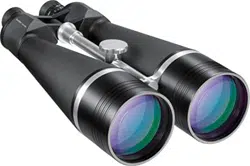
IN 251 Rev E 01/09
Customer Support (800) 676-1343
Email: [email protected]
Corporate Offices (831) 763-7000
89 Hangar Way, Watsonville, CA 95076
Providing Exceptional Consumer Optical Products Since 1975
Orion
®
GiantView
™
Binoculars
#9327 15x70 model
#9324 20x80 model
#9326 25x100 model
Congratulations on your purchase of a pair of quality Orion bin-
oculars. The GiantView binoculars provide the large light grasp you
need for astronomical observation, and unlike a telescope, allow
you to use both eyes simultaneously for nighttime, or daytime, view-
ing. This results in better image resolution, contrast, and brightness
than a similar sized telescope can provide. Coupled with their wide
fields of view, the GiantViews will make you feel like you’re floating
in space!
Please take the time to read this instruction sheet before using
your new binoculars.
Using the Tripod Mounting Post
When observing with large-aperture binoculars like the Orion
GiantViews, a photo tripod or some other type of binocular mount
is recommended. This is because the weight and high magnifica-
tion of the binoculars make it difficult to hold them steady by hand.
To attach the 70mm GiantView binoculars to a tripod, an optional
binocular-to-tripod L-adapter bracket is required; this is available
from the Orion catalog or telescope.com. The L-adapter threads
into the socket on the binoculars’ bridge (hinge). Refer to Figure 1.
Remove the threaded cover from the socket, and thread in the L-
adapter’s stud. The L-adapter connects to a standard photo tripod
or binocular mount via the ¼”-20 threaded holes in its base, thus
coupling the binocular to the tripod.
The 80mm and 100mm GiantView binoculars can be attached to
a standard photo tripod by means of its integral tripod mounting
post (Figure 1). Simply thread the ¼"-20 stud of your tripod into the
threaded socket on the underside of the mounting post. The tripod
mounting post can be positioned anywhere along the brace rod to
optimize balance. To do this, first loosen the large knurled knob on
top of the post (Figure 1). Then, grip the binoculars and move them
forward or backwards relative to the post until the balance seems
about right. Re-tighten the knurled knob on the post when done.
The brace rod allows positioning of the binoculars relative to the
tripod mounting post, but also provides additional stability for the
binocular barrels. This helps maintain structural rigidity and optical
alignment.
Adjusting the Distance Between Your Eyes
(Interpupillary Distance)
Hold each barrel firmly and move them together or apart so the dis-
tance between the eyepieces matches the distance between your
eyes. When properly adjusted, you should see a single, round field
of view when looking through the binoculars. Make this adjustment
before you focus the binoculars.
Focusing
The Orion GiantView binoculars feature individual focus eyepieces.
This makes the binoculars mechanically more rugged than simi-
lar center-focus models, and generally maintains optical alignment
better. For astronomical observation, individual focus eyepieces
are usually preferred.
Pick an object in the distance to view. At night, best focus will be
achieved by focusing on a bright star. Cover your right eye (or cover
the right objective lens of the binocular) and focus the left eyepiece
by rotating it until the image appears clearest. Then cover your left
eye (or cover the left objective lens of the binocular) and focus the
right eyepiece by rotating it until the image appears clearest. The
binoculars are now focused. If you want to view an object at a dif-
ferent distance, re-focusing of both eyepieces is required.
For astronomical observation, all objects will always appear focused
at the infinity focus point. This means you only need to focus the
binoculars once per observing session. This also means you can
take note of the diopter scale setting for each eyepiece (located on
the underside of the eyepieces) when focused on an astronomical
object, and return to those settings when observing another night.
You will find this to be a great convenience.
Since everyone’s eyes focus images slightly differently, different
observers will need to refocus the binoculars for their own vision.
Brace rod
Tripod mounting post
Large knurled knob
WARNING Never look directly at the Sun through
your binoculars without professionally made
solar filters, even for an instant, or permanent eye
damage could result. Young children should use
these binoculars on sunny days only with adult
supervision.
Figure 1. The GiantView 70mm, 80mm, and 100mm binoculars.
Socket
Loading ...
